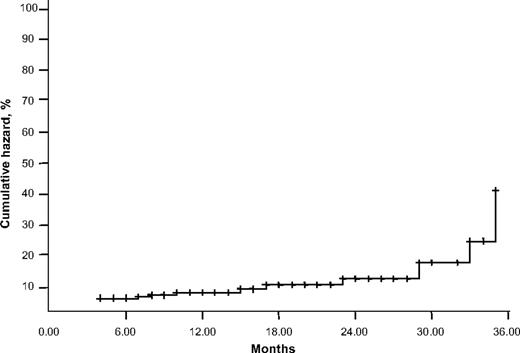In recent years, an increasing number of reports have pointed out the association between osteonecrosis of the jaws (ONJ) and the use of bisphosphonates as therapy of neoplastic bone disease or benign osteoporosis.1,2 The pathogenesis of this complication is unknown, although bisphosphonate-induced impaired bone resorption is likely to play a crucial role. Moreover, the relative contribution of microtrauma from chewing, repeated dental procedures, poor oral hygiene, cancer bone involvement, and concomitant chemotherapy has not been clarified yet.
In an attempt to identify the incidence of ONJ in a large, homogeneous series of patients with newly diagnosed multiple myeloma (MM) and to define the possible pathogenetic role of concurrent antimyeloma therapy, we retrospectively reviewed a series of 259 consecutive patients with symptomatic MM who were enrolled in the Bologna 2002 clinical trial.3 By study design, all patients received 4 months of primary therapy with thalidomide (200 mg/d) combined with high-dose dexamethasone (40 mg/d on days 1-4, 9-12, and 17-20 on odd cycles and on days 1-4 on even cycles) followed by double autologous transplantation with 200 mg melphalan/m2. Daily thalidomide (200 mg/d) and monthly courses of dexamethasone were continued until the second autologous transplantation. Intravenous zoledronic acid 4 mg every 28 days was administered throughout the whole treatment period and continued thereafter, at physician's discretion. Only patients receiving zoledronic acid for longer than 4 months were included in the present analysis.
Overall, 9 patients (3.47%) presented with suspicious findings of ONJ, which was subsequently confirmed at oral/maxillofacial diagnostic workup. As previously reported,4-6 the duration of exposure to bisphosphonates was closely related to an increased incidence of ONJ; median duration of zoledronic acid therapy (10 months; range, 4-35 months, in the whole patient population) was significantly longer among patients experiencing ONJ compared with patients who did not show this complication (17 versus 10 months, respectively; P < .01) (Figure 1). ONJ occurred in the mandible in 6 cases (66.6%); symptoms of pain, swelling, or purulent discharge were present in all but one patient who was diagnosed as having exposed bone at routine dentistry examination. Four patients had a complete response to minimally invasive treatment and 3 patients showed a partial improvement, while no improvement was observed in the last 2 patients in whom a monoclonal plasma cell infiltrate of the mandible was detected.
Cumulative risk of developing ONJ according to time of exposure to zoledronic acid.
Cumulative risk of developing ONJ according to time of exposure to zoledronic acid.
Although patients' follow-up was shorter than in other studies, possibly accounting for the lower incidence of ONJ compared with that reported by others,4-6 the rate of ONJ after 24 months of zoledronic acid exposure was 6.6%, a value comparable with those found in other analyses.5,7 This observation might suggest that neither antiangiogenic activity of thalidomide, nor impaired bone remodeling related to dexamethasone, nor severe immunosuppression induced by high-dose melphalan was an important additional risk factor for the development of ONJ. Bisphosphonates represent the standard of care for treatment and prevention of MM-related bone disease8 ; however, both physicians and patients should be aware of ONJ as a possible complication, and more attention should be paid to preventive measures.9,10
The authors declare no competing financial interests.
This work was supported by Università di Bologna, Progetti di Ricerca ex-60% (M.C.); Ministero dell'Università e Ricerca Scientifica (MIUR), progetto Fondo per gli Investimenti della Ricerca di Base (FIRB) (RBAU012E9A_001; M.C.); and Fondazione Carisbo. The following is a list of additional investigators who participated in the Bologna 2002 study and provided data for the present analysis (all located in Italy): Luciano Masini (Reggio Emilia); Francesca Patriarca (Udine); Antonio Francesco Casulli (Taranto); Alessandro Gozzetti (Siena); Antonio Ledda (Cagliari); Filippo Gherlinzoni (Treviso); Catia Bigazzi (Ascoli Piceno); Giuliana Leopardi (Pesaro); Antonio Lazzaro (Piacenza); and Luciano Guardigni (Cesena).


